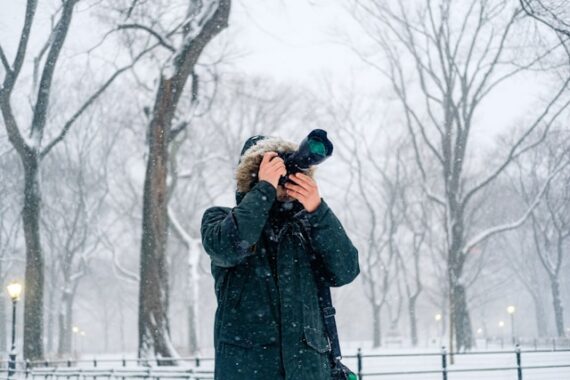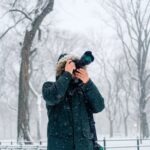Fogged lenses and frosty glass are two of the most common problems winter photographers face. One minute your lens is clear and sharp, and the next it’s covered in haze or tiny ice crystals that destroy contrast and detail. The good news is that both problems come down to one thing—condensation—and once you understand how it forms, it’s easy to prevent.
Related: offer ending soon for the Photo Adventure Cheat Sheets 🎁 Pre-Black Friday Sale
Why Lenses Fog or Frost in the First Place
Fog happens when cold gear enters warm, humid air. The warm air condenses on the cold glass faster than it can evaporate, leaving a milky haze that can last up to an hour.
Frost is the same process in reverse. Take warm gear into freezing temperatures and moisture in the air freezes on the lens surface, creating tiny crystals that are almost impossible to wipe off cleanly.
Stop Fog Before It Starts
The simplest and most reliable method is to seal your camera in a zip-lock or dry bag before going indoors. While your gear warms up, all the condensation forms on the bag instead of the lens. Leave it sealed until everything reaches room temperature.
You can also minimize temperature shock by keeping your gear at a stable cold temperature whenever possible. If you’re shooting on and off throughout the day, leave your camera in a cold car trunk or garage rather than letting it repeatedly warm up and cool down.
Another common trigger for fog is hopping into a heated car after a shoot. Car heaters pump out very humid air, and lenses fog instantly. If you need to get into the car, bag the camera first or keep it in the trunk where the temperature rises slowly.
Keeping Frost Off Your Lens Outdoors
Ice crystals usually form from your own breath or body heat rather than the environment. A lens hood helps create a small barrier that keeps warm air and falling snow away from the glass. When composing, be conscious of where you’re breathing—one exhale too close to the front element can frost it over in seconds.
Letting your gear acclimate to the cold before shooting also helps. A lens that’s already cold is less likely to attract moisture or freeze it. If frost does start forming, avoid wiping it; melting and smearing creates a bigger problem. A simple rocket blower is the safest way to clear early flakes or crystals.
What to Do If Fog or Frost Already Happened
Once a lens fogs, patience is your best tool. Don’t wipe it—smearing condensation across the coatings only complicates things. Set the lens in a dry room and allow it to naturally warm up and clear. Silica gel packs inside your camera bag can speed up drying and help prevent repeated fogging throughout the day.
Final Thoughts
Winter is hard on camera gear, but fogged and frosted lenses are almost always preventable. Slow temperature changes, sealed bags, and a bit of breath awareness go a long way. With a few simple habits, your glass stays dry and crystal-clear—even in snowstorms and sub-zero conditions.
For Further Training:
For help preparing and remembering camera settings for difficult situations like this, a set of Photography Adventure Cheat Sheets are designed to help. They are currently 80% off for a Pre-Black Friday🎁 which ends soon if you want to check them out.
The perfect companion for any photographer. Print one out whenever you need it. Whether you’re going on vacation or seeking out a specific photography adventure, these cheat sheets can provide you with the knowledge and inspiration you need to create your best work yet.
Deal ending soon: Photo Adventure Cheat Sheets 🎁 Pre-Black Friday Sale
Like This Article?
Don't Miss The Next One!
Join over 100,000 photographers of all experience levels who receive our free photography tips and articles to stay current:








Leave a Reply